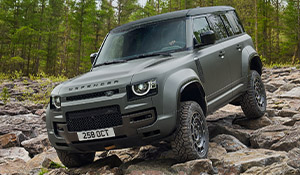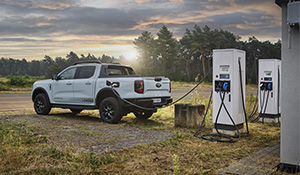HEAD TO HEAD: FORD EVEREST TREND VS ISUZU MU-X LS-U
What Are We Testing And Why?
While Ford and Isuzu have taken a similar path by developing the Everest and MU-X 4x4 wagons on their respective utility platforms (Ranger and D-MAX), they have taken very different approaches when it comes to marketing said vehicles. Ford has aimed high, pitching its well-equipped Everest at the larger Toyota Prado in terms of equipment and price, while Isuzu has aimed its more basic albeit still very good MU-X at a lower price point.

Both 4x4 Everest and MU-X wagons are available in three trim levels. For Ford that means the auto-only Everest 4x4 comes in Ambiente ($52,990), Trend ($58,990) and Titanium ($74,701) grades. The MU-X 4x4 comes in LS-M ($48,000), LS-U ($50,300) and auto-only LS-T ($56,100) variants. If you want an auto on MU-X LS-M and LS-U grades it adds $2100 to the price. For this head-to-head battle we’re comparing the mid-spec Everest Trend with the MU-X LS-U auto, the Isuzu undercutting the Ford by $6590.

Under the bonnet of the Everest you’ll find a 3.2-litre five-cylinder turbo-diesel engine that’s mated to a six-speed auto transmission. The MU-X has a 3.0-litre four-cylinder turbo-diesel engine also mated to a six-speed auto. Everest and MU-X run the two largest-capacity engines in the class (Trailblazer and Fortuner run 2.8L four-cylinder engines and Pajero Sport a 2.4L four-cylinder). Both vehicles offer seating for seven, tough separate body-on-chassis construction, independent front suspension with coilover struts, live-axle rear-ends with coil springs and two-speed transfer cases. While the MU-X makes do with a part-time 4x4 system, the Everest has a more sophisticated full-time 4x4 system.

The Everest Trend is equipped with 18-inch alloy wheels, a 10-speaker audio system with steering wheel controls, an 8-inch colour touchscreen, dual 4.2-inch colour instrument screens, Apple CarPlay/Android Auto, satnav, automatic high beam, a power tailgate, second- and third-row privacy glass, 230V inverter, four 12V power outlets, two USB ports, dual-zone climate control air conditioning, keyless entry, rain-sensing wipers and auto high-beam.
In LS-U spec the MU-X is equipped with 18-inch alloy wheels, audio system with steering wheel controls and iPod input, an-8-inch colour touchscreen, Multi-Information Display, satnav, second- and third-row privacy glass, two 12V power outlets, two USB ports, climate control air conditioning and keyless entry/start.

What’s The Interior Like In The Everest And MU-X?
The Everest interior offers a contemporary design and well-positioned instruments and controls. The eight-inch touchscreen is located up nice and high where it’s easy to see and operate, and the instrument binnacle offers all the information you’ll ever need… and then some. There are big rotary dials for sound system volume and radio tune, as well as steering wheel controls. The power/USB outlets are well situated on the centre console and the controls for the Terrain Management System (TMS), high/low ratios and rear diff lock are clearly marked and easy to use.
The MU-X interior has a less luxurious air than the Everest. The colour touchscreen is well positioned but the air conditioning controls are in a strange, circular layout, while the MU-X’s basic part-time 4x4 system (called Terrain Command) is operated by a big dial on the centre console with three positions: 2H, 4H and 4L.

It’s not hard to find a comfortable driving position in either vehicle as they both offer plenty of scope for adjustment. Second-row seat occupants will also be pleased with the amount of width on offer in both vehicles, although those in the MU-X don’t have access to 12V power.
Both vehicles have air conditioning vents in all three rows. The MU-X has the edge in regards to space and comfort for third-row occupants, but it’s a close call. On the flipside, the Everest offers more cargo space. With second- and third-row seats folded, both vehicles offer long and flat cargo floors, but the MU-X’s is slightly raised, making loading and unloading a little less convenient.

What Are The Everest And MU-X Like To Drive?
The Everest is the more refined of the two vehicles on the open road. Its five-cylinder engine is smooth and the Everest features an active noise cancelling system that results in a quiet cabin at highway speeds. Despite its commercial vehicle underpinnings, the Everest also provides good ride quality and responsive handling.
With 147kW or power and a healthy 470Nm torque peak, the Everest’s 3.2-litre five-cylinder engine delivers effortless performance, and it works well with the smooth shifting six-speed automatic transmission.
Isuzu went to some effort in 2017 to improve the MU-X’s refinement, but it’s still not a match for the Everest. The 3.0-litre four-cylinder turbo-diesel engine is not the smoothest powerplant and it can sound a little raucous when revved hard.

The more powerful Everest has an on-road edge but the MU-X still delivers more than adequate on-road performance, and it has a strong midrange, which means it doesn’t need to be revved hard to deliver its best, negating some of its gruffness; the 430Nm torque peak is developed low in the rev range (from 2000-2200rpm). The MU-X’s six-speed auto shifts through its ratios smoothly and predictably.
The MU-X provides a comfortable and compliant ride over rough surfaces thanks to soft spring and damping rates, but it also exhibits more body roll than the Everest when cornering, and doesn’t feel quite as lively.

What Are The Everest And MU-X Like Off Road?
The Ford Everest is a capable off-road vehicle; it offers decent ground clearance, short front and rear overhangs, plenty of rear wheel travel, good low-range reduction, an effective traction control system and a locking rear diff. The Everest also features a sophisticated Terrain Management System with selectable drive modes that tailor vehicle response to suit different terrains: Snow/Grass/Gravel, Sand and Rock modes.

The Everest uses its traction control system and locking rear diff to good effect on steep, rocky climbs or undulating tracks that test a vehicle’s suspension travel. Even when the rear diff lock is engaged, the TC still operates on the front axle, so the Everest is able to climb up and over obstacles that can trip up some other vehicles. And its in these conditions that the MU-X can struggle; when it runs out of wheel travel on undulating terrain its less sophisticated traction control system struggles to prevent wheel spin. And without a rear diff lock the MU-X simply can’t match the Everest in such conditions.
In most other off-road conditions, however, the MU-X performs well enough. It offers plenty of ground clearance, good approach and departure angles, effective low-range gearing, plenty of useable torque and, like Everest, it has an off-road friendly tyre size.

What Safety Features Do The Everest And MU-X Get?
Both the Everest and the MU-X have been awarded a five-star ANCAP rating.
The Ford Everest Trend is equipped with safety features including reversing camera, rear parking sensors, Dynamic Stability Control, Traction Control, Rollover Mitigation and Trailer Sway Control, a full complement of airbags and Driver Assist Technology (adaptive cruise control, forward collision alert and lane keeping system). If you want Active Park Assist, Cross Traffic Alert and a tyre pressure monitor, you’ll have to fork out $74,704 for the top-spec Everest Titanium.
The Isuzu MU-X LS-U is equipped with ABS with EBD, traction and stability control, EBA, hill descent control, reversing camera, rear parking sensors, six airbags, LED headlights with auto levelling and fog lights.

So, Which One Wins And Why?
There’s no doubting the Ford Everest Trend is a better overall package than the Isuzu MU-X LS-U auto, but $6590 better? Well, yes. The Everest is bigger, more powerful, more refined and it has a far more sophisticated and effective 4x4 system.
If your budget doesn’t stretch to the Everest Trend you could always opt for the more affordable $52,990 Everest Ambiente, which is only $590 more than the MU-X LS-U. You’ll miss out on some Trend features such as Driver Assist Technology (adaptive cruise control, forward collision alert and lane keeping system), satnav, automatic high beam and power tailgate, but even in lower-grade Ambiente spec the Everest still trumps the MU-X LS-U with its Terrain Management System and locking rear diff.
Examined in isolation, the Isuzu MU-X LS-U auto is a great package – it’s spacious, offers strong on-road performance, good off-road capability and a class-equalling 3000kg towing capacity – but it doesn’t stack up when compared directly with the Ford Everest Trend.

Ford Everest Trend
Pricing: $58,990+ORC
Warranty: three-years, 100,000km
Safety: Five star ANCAP
Engine: 3.2-litre five-cylinder turbo-diesel
Power: 143kW at 3000rpm
Torque: 470Nm at 1750-2500rpm
Transmission: six-speed automatic
Drive: full-time four-wheel drive
Dimensions: 4892mm (L); 1860mm (W); 1837mm (H)
Turning Circle: 11.7m
Ground Clearance: 225mm
Boot Space: 450/1050/2010 litres
Spare: Full size
Fuel Tank: 80L
Thirst: 8.5L/100km (combined)
Isuzu MU-X LS-U (auto)
Pricing: $52,400+ORC
Warranty: five-years, 130,000km
Safety: Five star ANCAP
Engine: 3.0-litre four-cylinder turbo-diesel
Power: 130kW at 3600rpm
Torque: 430Nm at 2000-2200rpm
Transmission: six-speed automatic
Drive: part-time four-wheel drive
Dimensions: 4825mm (L); 1860mm (W); 1860mm (H)
Turning Circle: 11.6m
Ground Clearance: 230mm
Boot Space: 235/878/1830 litres
Spare: Full size
Fuel Tank: 65L
Thirst: From 7.9/100km (combined)









